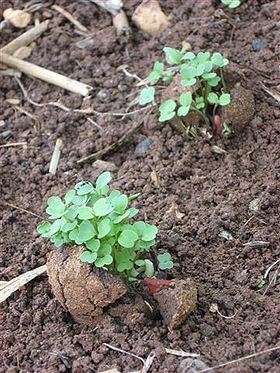How to Use Seedballs to Improve Biodiversity
Seedballs


Seedballs are based on the work of Fukuoka Masanobu (Author of "The One Straw Evolution"). It is a method of encapsulating compost and plant seeds within a big "marble" of clay, which can then be dropped, rolled or hurled into a location of one's choice.
While in the nature, the balls are protecting the seeds from being blown away by the wind or washed away by water, eaten by animals or desiccated in the sun. When there is enough rain water, the seedballs melt and the clay acts as a reservoir keeping the young plant moist.
By choosing several plant species which are appropriate to each type of target area (eg. shade-loving plants, or fast growth "hardies") we can then let Nature decide which plant will flourish in a particular microclimate, rather than forcing the issue as in the case of tree planting.
Gathering seeds is a pleasure and a person can make several hundred seedballs in a day. It's a very gentle and mellow activity, that children may also enjoy.
Caution
- This technique is quite powerful, so be sure that you use only native, non-invasive plants!!!
- There might be some work in preparing the seeds between collection and seed-balling. Also, not all seeds can stay "alive" (keep the ability to germinate) in the clay ball long enough before they get the chance to germinate.
- The seeds may take some time to sprout and grow. Maybe even only the next season. This is not an instant rewarding action, but many seeds have good chances to grow under these conditions.
How ?
You will need:
- 5 parts clay earth,
- 3 parts organic compost,
- 1 part water
- 1 part seeds.
The clay can either be harvested from the nature, in dry riverbeds for example. It is practical to have it in powdered form, so dry it and grind it up if it is wet.
The compost is organic matter and already contains the microorganisms that will help the plant's roots to take nutrients from the surrounding soil. It can be either homemade or you can buy it by a farmer or in a gardening shop.
The seeds can either of one only plant to have a monoculture or a combination of many seeds for reintroducing biodiversity and reclaiming dead areas. Ideally have a mix that includes types of seeds that will do well in a variety of conditions appropriate to your climate and needs. The best is to gather local seeds of wildflower and grass: thanks the seedball method you can enhance their reproduction in your bioregion.
- Mix the clay, seeds and organic compost together in a big pot and add enough water to form a thick paste.
- Form this paste into little balls about the size of a marble.
- Let them dry in the shade into hard little balls.
- To apply, throw the seedballs where you want to spread the plants. The clay protects from predators. The seeds actually sprout inside the ball and take hold.
You don't need to PLANT the seedballs in the soil...! The seeds are already planted in the balls.
- Fencing the area where you spread the seedballs will protect the young plants from being eaten by mammals, and will stronly improve the implantation.
Links and references
Film about Fukuoka Masanobu (German)
Related Articles
Categories
[
- Stub
- Agriculture
- Community
- Composting
- Crops
- Education
- Fertilizer
- Forest
- Fruits
- Ideas
- Resource Management
- Soil
- Run-Off
- Tree
- Vegetables
- Sun
- Wind
- Biodiversity
- Easy
- Global Technology
- Arid Climate
- Forest Environment
- Global
- Mediterranean Climate
- Monsoon Climate
- Montaneous Environment
- Coastal Area
- Lakes and Rivers
- Rural Environment
- Temperate Climate
- Tropical Climate
- Less than 10 US$
- Clay
- Compost
- Kaolin
- Manure
- Sand
- Seeds
- Seedlings
- One Person and more
- Household
- Village
- Neighbourhood
- Application
- Howtopedia requested drawings
- Howtopedia requested images
- Requested translation to Spanish
- Requested translation to French